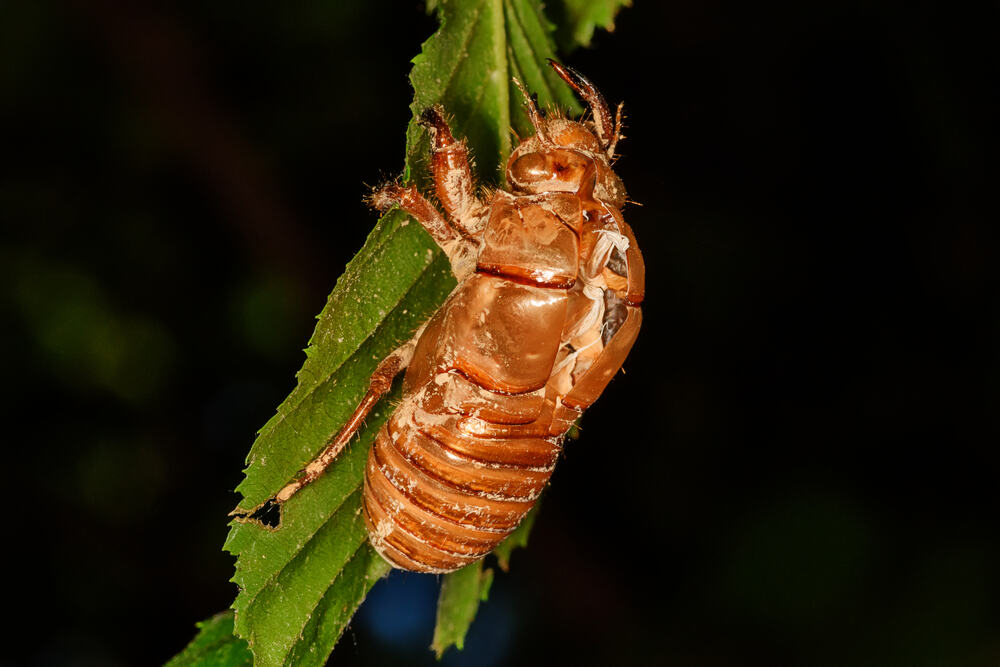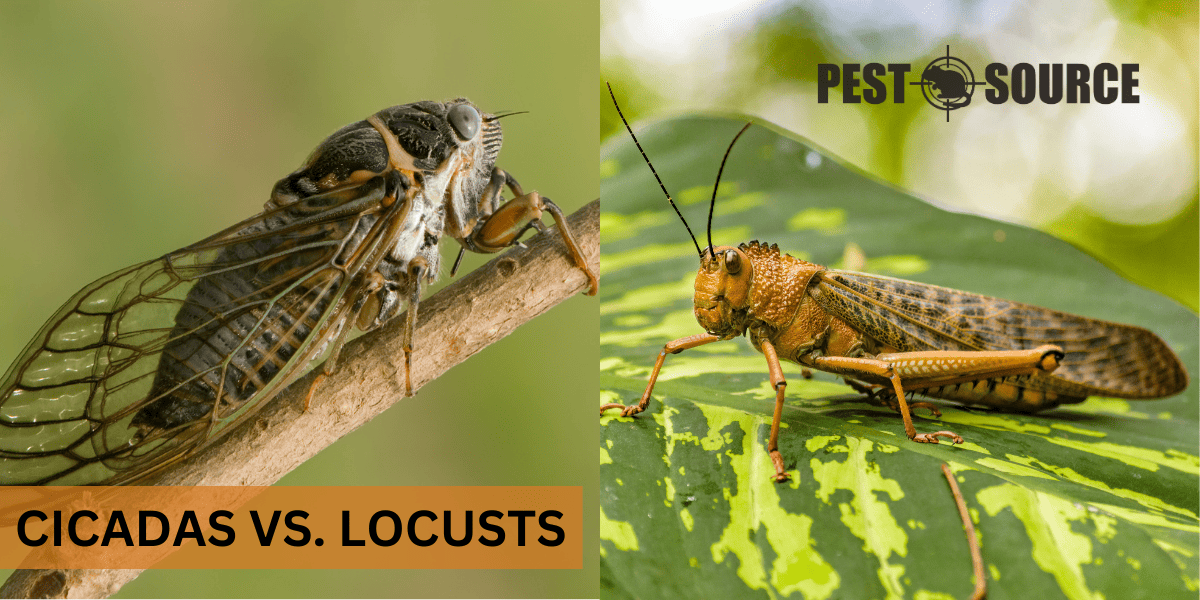Cicadas and locusts are often confused but belong to different insect families. Cicadas are known for their loud mating calls and spend years underground before emerging, while locusts are a type of grasshopper that can form destructive swarms when conditions trigger their swarming behavior. Dive into the distinctions between these two insects, including their behavior, lifecycle, and impact on the environment.
POINTS
- Cicadas and locusts belong to different taxonomic orders, with cicadas in Hemiptera and locusts in Orthoptera, and they have distinct lifecycles and behaviors.
- The confusion between cicadas and locusts historically stems from the mass emergence of cicadas being likened to locust plagues, despite locusts being grasshopper-like insects that form destructive swarms.
- Cicadas produce one of the loudest insect sounds to attract mates, using tymbals on their abdomens, while locusts create softer chirping sounds for communication within swarms by stridulating their hind legs against their wings.
- The loud cicada calls serve to attract females and deter predators through predator satiation, whereas locust sounds maintain swarm cohesion and facilitate mate location within the group.
- Cicada exuviae are identifiable by their split back and large eye sockets, indicative of their unique emergence behavior, while locust exuviae are smaller, less conspicuous, and suggest a more transient lifestyle.
What’s the Difference Between a Cicada and a Locust?
Defining Cicadas and Locusts
Cicadas and locusts are distinct groups of insects that belong to different taxonomic classifications. Cicadas are part of the order Hemiptera, which includes true bugs, and are known for their large, transparent wings and distinctive mating calls. They have a unique lifecycle that includes a prolonged period of underground development that can last several years, followed by a brief adult stage above ground.
Locusts, on the other hand, are a type of short-horned grasshoppers from the family Acrididae, within the order Orthoptera. They are characterized by their ability to change behavior (solitary to gregarious) and form large swarms that can travel great distances. Unlike cicadas, locusts have a shorter lifecycle and can breed rapidly under favorable conditions, leading to population explosions.
Clarifying the Confusion Between Cicadas and Locusts
The reason cicadas are often mistakenly called locusts stems from historical events. Early American settlers, witnessing the mass emergence of periodical cicadas, associated them with the Biblical plagues of locusts due to their overwhelming numbers. However, this is a misnomer, as true locusts are grasshopper-like insects that can form destructive swarms, a behavior not seen in cicadas.
Habitat Preferences and Geographical Distribution
Cicadas are found worldwide, with a notable diversity in temperate and tropical regions. They typically prefer wooded areas where they can feed on plant sap using their piercing mouthparts. In contrast, locasts inhabit a variety of regions but are most notorious in parts of Africa, Asia, and the Middle East where they can become agricultural pests. Locusts are adapted to environments that range from grasslands to semi-arid regions, where they can rapidly reproduce in response to favorable weather conditions.
Are Cicadas and Locusts the Same Thing?
Ecological Roles of Cicadas and Locusts
The ecological roles of cicadas and locusts are quite distinct. Cicadas play a significant role in their ecosystems as both predators and prey. Their emergence provides a food source for a wide variety of wildlife, and their nymphs aerate the soil while feeding on underground roots.
Locusts, conversely, are known for their impact on agriculture. In their swarming phase, they can devastate crops and cause significant economic damage. This behavior has far-reaching effects not only on the immediate environment but also on the livelihoods of people in affected regions.
Comparing Behaviors: Swarming vs. Periodic Emergence
Cicadas are best known for their periodic emergence, with some species, like the periodical cicadas, appearing en masse every 13 or 17 years. This synchronized emergence is a survival strategy to overwhelm predators with their sheer numbers, ensuring the continuation of the species.
Locusts exhibit a behavior known as swarming, which is a response to certain environmental triggers such as drought followed by rapid vegetation growth. These swarms can consist of billions of individuals and serve as a means for locusts to find new food sources and breeding grounds. The contrast between the two insects’ behaviors is stark: cicadas emerge periodically in predictable cycles, while locust swarms are irregular and often associated with unpredictable environmental changes.
Locust vs Cicada Sound: What’s the Difference?
Sounds Produced by Locusts and Cicadas
The sounds produced by both locusts and cicadas are iconic, yet they differ significantly in intensity, frequency, and patterns. Cicadas are renowned for their loud, buzzing calls, which can reach up to 120 decibels, making them one of the loudest insects. These sounds are primarily made by male cicadas to attract females and are produced by rapidly vibrating structures called tymbals on their abdomens.
Locusts, in contrast, create sound by rubbing their hind legs against their wings, a process known as stridulation. The sound of a locust is more of a soft, continuous chirping, which is less intense than the cicada’s call. Locusts use sound for communication within the swarm and to facilitate mating.
Biological Mechanisms and Survival Strategies
The differences in sound reveal differing biological mechanisms and survival strategies between the two species. Cicadas use their loud calls to saturate the auditory environment, ensuring that their mating message is heard over long distances. This strategy is particularly effective when considering their short adult lifespan, which necessitates quick and efficient mate location.
Locusts, however, use their sound as part of a collective communication system within swarms. The softer chirping contributes to the cohesion of the swarm, making it easier for locusts to stay together while on the move. This is crucial for their survival as a migratory pest, allowing them to respond to environmental cues and locate new food sources as a group.
What is the Difference Between Locust and Cicada Shells?
Analyzing the Exuviae of Locusts and Cicadas
The exuviae, or molted shells, left behind by locusts and cicadas provide valuable clues for identifying and differentiating between the two species. Cicada exuviae are commonly found attached to tree trunks or other surfaces. They are notable for their split back, where the adult cicada emerges, and their large, empty eye sockets.

Locust exuviae, while similar in that they are the shed skin of the insect’s nymph stage, are generally smaller and less conspicuous than cicada shells. They may be found on the ground or low vegetation and lack the pronounced eye sockets and split back characteristic of cicada exuviae.
Clues Offered by Shells for Identification
The shells of these insects are not only different in appearance but also offer clues about the life history of the species. Cicada shells indicate a life cycle that involves a long period of underground development, followed by a synchronized emergence. The presence of numerous cicada exuviae in an area can signal the recent mass emergence of a brood.
Locust shells, being less commonly found due to the insects’ more transient and mobile lifestyle, suggest a different life strategy that involves frequent movement and less synchronization in development stages. Recognizing these differences in exuviae can help in identifying and understanding the unique behaviors and life cycles of locusts and cicadas.
What Do Cicadas Look Like?
The appearance of cicadas is characterized by their stout bodies, broad heads, clear-membrane wings with conspicuous veins, and large compound eyes situated on either side of their head. They range in size from about 2 to 5 centimeters (0.8 to 2 inches), and their color patterns vary from greens and browns to black, often with white, green or blue eyes. Most species have a set of transparent wings held roof-like over their bodies. The front wings are notably longer than the rear pair and have a distinctive series of veins, including a Y-shaped one near the outer edge, which helps in identifying them.



